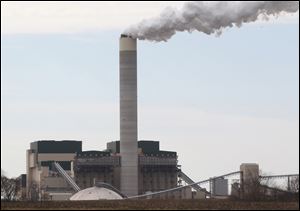
Area utilities face possible 30% rate hike
5/23/2012
The Prairie State Energy Campus is to start generating power soon. Its cost has risen from a $2 billion estimate to nearly $5 billion.
With electric rates currently at competitively lower prices, several municipal utilities in northwest Ohio are locked into agreements to buy power for the next three decades from a new plant in Illinois whose cost overruns could drive its power delivery rates up by as much as 30 percent.
The Prairie State Energy Campus, a "clean coal" plant that is the largest U.S. coal-fired complex built in 30 years, is nearly ready to start producing some of its promised 1,600 megawatts — six months after it had been expected to be ready.
When it was announced in 2001, the plant's cost was estimated at $2 billion, but since construction began in 2007 the price has grown to nearly $5 billion. The plant meets stringent Environmental Protection Agency guidelines for emissions even though it burns high-sulphur coal, which is mined on the plant site.
Last year the Chicago Tribune reported that the Illinois Municipal Electric Agency, an association of 33 cities that owns a 15 percent stake in the plant, predicted that its electric delivery rates to member communities would increase to $63.40 a megawatt hour in 2013, up 30 percent from 2007, largely because of their investment in the Prairie State project and a smaller coal-fired plant in Kentucky.
In Ohio, American Municipal Power Inc., an association of 83 cities, holds a 23 percent stake in the Prairie State plant funded by 60 of the 83 Ohio cities that are members of AMP. The cities have contracted to buy power from the plant for the next 29 years.
According to the Tribune report, documents with the Illinois communities show their contracts will require higher electricity rates to cover the plant's construction overruns.
Officials from four northwest Ohio communities that invested in the project said that although their electric rates from Prairie State may increase, they still consider the plant a good investment.
"I was aware of this, and it does not concern me," said Brian O'Connell, utilities director for the city of Bowling Green.
"When the board of public utilities made the decision to take part in the Prairie State project, power prices were much higher. They were very sporadic," he said. "Bowling Green was more exposed to market pressures. We were more at risk for those high prices that were at pre-2008 levels."
Mr. O'Connell said a city such as Bowling Green views Prairie State as a way to stabilize costs for its citizens over the next three decades. "Right now the prices we see are a snapshot in time, and it could very easily occur in a year or less that we could see prices go up," he added.
Currently, a megawatt of power on the spot market is about $20 to $25, according to daily statistics from PJM Interconnection, the operator that controls the electric power grid for much of the East and the Midwest, including most of Ohio.
Mr. O'Connell said that if the economy revives, natural gas prices that currently are keeping electric prices down could rise, taking electricity prices with them.
"It hasn't been mentioned in some articles that there's a large number of coal-fired plants that are going to be shut off in the future and that's going to decrease the availability of power and could drive prices higher," he said.
"We're looking at the long-term benefit. Of the other communities I've talked to, I've not seen any come up to say this is a huge cost overrun. … There are no alarms in my mind saying this was a bad decision," he added.
Robert Pauley, village administrator for Oak Harbor, another investor in Prairie State, said he was unaware of potential electric rate increases but said that Oak Harbor is committed to buying only a certain percentage of power annually from Prairie State, and it has a diversified power portfolio.
"As far as the increase, this is the first time I'm hearing of it. I knew there were delays in start-up. But we still view Prairie State as an important part of our energy portfolio," he said. Oak Harbor also gets power from solar, wind, and hydro projects and a significant amount from the nearby Fremont Energy Center, a natural-gas-fired plant that provides low-cost energy.
"The way we charge customers is a blended cost," Mr. Pauley said.
He added that there isn't much chance of higher prices from Prairie State having a big impact.
Kevin Gladden, village administrator in Genoa, which also invested in Prairie State, echoed Mr. Pauley's sentiments. "We contracted for 900 kilowatts. That isn't very much," said Mr. Gladden, who said Genoa also has a varied portfolio with power coming from multiple sources.
"I know there's been cost overruns and that they are behind schedule. But they have contingencies built in," he said. "If they overrun past a certain point, that doesn't affect us. And until they go online and we see what they're producing, [pricing] doesn't seem to be that issue with the board."
Mr. Gladden said he doesn't believe Prairie State's electric power rates are going to go up 25 or 30 percent when rates are finally determined. "But we won't know that until it's up and running."
Craig Preston, municipal utilities assistant director in Bryan, another AMP member and Prairie State investor, said he doesn't believe the overruns since construction began are that severe.
"We're aware of them and we kind of watch what's going on, but from what I understand [the overruns are] not as high as what people are reporting," Mr. Preston said.
"From our viewing point, this is a future project and the cost down the road is going to be well worth it."
Contact Jon Chavez at: jchavez@theblade.com or 419-724-6128.